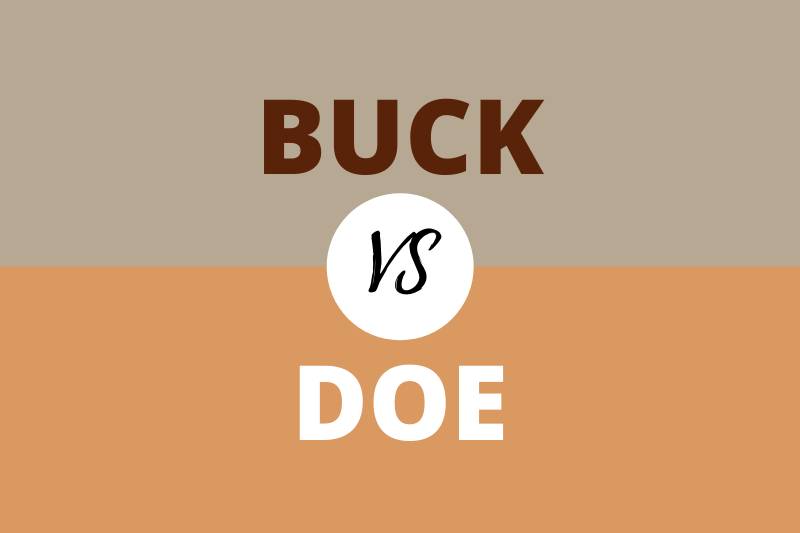Before we give our final word on if there is really any difference between Left Twix and Right Twix, let us remember why love our chocolates.
Comparison Table: Buck vs Doe
| Criteria | Buck | Doe |
|---|---|---|
| Gender | Bucks are male deer. | Does are female deer. |
| Antlers | Bucks have antlers in their head. It helps them to defend themselves. | Does do not have antlers on their head. |
| Physical Traits | Bucks have a flat head and smaller snouts. | Does have a round-shaped head and long snouts. |
| Social Behavior | Bucks do not engage in any group activities. They only meet the Does during mating season. They prefer to live alone. | Does always live in groups along with other female deer. They search for food and move around in groups as well. |
| Parenting | Bucks do not engage in any part of the parenting process. They like to stay alone and do not include themselves with the fawns. | Does provide care and nourishment to the young ones. When the fawns are born, they tag along with their mothers. The Does are responsible for taking care of the fawns. |
| Identification | Bucks urinate while taking a walk. A passage of urine denotes the presence of a buck. | Does are known to urinate using a squat posture. Whenever an area smells like urine, a doe is likely to have passed by the region. |

About Buck
Buck is the male deer who moves solo. They do not feel the need to mix with the other bucks and look for does only during the mating season. Bucks prey and feed individually without each other’s help. They do not form an important part of the parenting process.
One of the physical traits of the Buck is the Antler. Antlers act as the living tissues that protect the bucks. It grows as a tough bone on the head of the bucks and is hard and heavy. The antler is used to defend themselves. It sheds once a year and then grows back.
The Bucks are comparatively heavier than the Does. The average weight is around 150 pounds and this forms an important trait. Bucks can live up to ten years.
About Doe
The female deer is known as a Doe. They come with multiple characteristics that are different from the male deer. Does are known for their roles as a caretaker. They look after the young ones and take parenting very seriously. Research states that the young fawns need the presence of the Does while they are growing. In the absence of the Does, the life of the fawns will be severely affected.
Unlike the Bucks, Does prefer living a different lifestyle which involves living in groups. They look for food using their groups. There is no involvement of bucks in such groups. When the fawns are born, they tag along with their mother. When it comes to the size, Does are smaller than Bucks.
The Deer species include Does as the smaller in size. The average weight is usually around 140 pounds and is weaker than bucks. Because of this reason, Does survive better while moving in herds. The Columbian Blacktail for example is only half the size of a buck.
The reproduction rate is high as does can reproduce starting at the age of 1 and continue till the day they die. Every three months, a fawn is produced.
Do you know? Theme vs Moral
Difference Between Buck and Doe
1) Groups
Does wander in groups throughout their lifetime. This way they can stay safe together. The Bucks on the other hand only meet the Does during mating season. Bucks live a solo lifestyle.
2) Physical difference
Does are smaller in size when compared to Bucks. They are also weaker and the Bucks are heavier than the Does.
3) Head shape
Doe has a round-shaped head and is known for its long snouts. Buck, on the other hand, has a shorter snout and the shape of their head is usually flat.
4) Parenting
Does spend half of their life caring for their young ones. They are responsible for the nourishment of the fawns. Bucks do not play any role in the parenting process.
5) Identification
Does do not have antlers on their head. Bucks have antlers on their head which they use to protect themselves from danger.
Do you know? Dell Vostro vs Inspiron
Summary
Does are the female deer who spent their entire lives caring for each other in a group. They produce multiple children during their lifetime and are usually weaker than males. Since they are smaller in size and weaker than the other animals, the Does prefer to walk around in groups along with their fawns.
Bucks on the other hand like living alone. They do not play a role in the parenting process. All the nourishment and care is given by the Doe to the fawn. The Buck does not wander in groups, rather they walk around alone and protect themselves using the antlers.
Naomi is an educator with 2 decades of experience working with children of all ages. She is a keen observer of the magic and importance of Maths in our daily lives. Follow me on Linkedin
